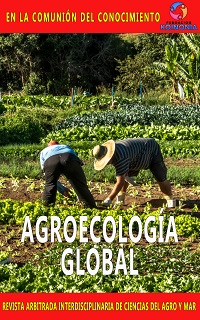Design of a marketing plan for the Flor de Jamaica
DOI:
https://doi.org/10.35381/a.g.v5i9.2585Keywords:
Marketing, flower, Jamaica, design, plan, (AGROVOC Thesaurus)Abstract
The objective of the research was to design a marketing plan for the Flor de Jamaica (Hibiscus sabdariffa L.) in the Miranda municipality, Falcón state. The methods or techniques used to carry out the research were interview and observation. The results indicated that the establishment in the soils of the CEPAEB community of the Cultivation of the Flower of Jamaica denotes a yield of 80% in terms of the plants in the plot, which makes its sowing feasible. In conclusion, the cultivation did not generate contamination since it was carried out without the use of polluting chemical products, for fertilization, pest control, diseases or weeds. Socialize the community in showing them the path towards the search for benefits that allow them to cover certain needs, through a greater boom in economic development. The economic sustainability can be seen reflected in the price to offer.
Downloads
References
Abou, A., Abu, S., & Abou, A. (2011). Physico-chemical properties of natural pigments (anthocyanin) extracted from roselle calyces (Hibiscus sabdariffa). Journal of American Science, 445-456. https://n9.cl/khr2u
Amarula productos naturales. (2011). Amarula productos naturales. [Amarula natural products ]. https://n9.cl/o6n1l
Babalola, S. O. (2001). Compositional attributes of the calyces of roselle (Hibiscus sabdariffa L.). Journal of Food Tecnologoy in Africa, 6(4) Africa. https://n9.cl/gyzkw
Ardila, L, y García, M. (2015). Elaboración de una bebida refrescante a base de Flor de Jamaica (Hibiscus Saddariffa L.) en la ciudad de Bucaramanga. [Preparation of a refreshing drink based on Flor de Jamaica (Hibiscus Saddariffa L.) in the city of Bucaramanga]. (Tesis de pregrado). Universidad de Nacional de Santander, Colombia. https://n9.cl/j372c
Ceballos, M. (2015). Procesamiento De La Flor De Jamaica (Hibiscus Sabdariffa L.) Desecado Para La Preparación De Yogurt Y Bebida Con Altas Propiedades Nutracéuticas. [Processing of the Jamaican Flower (Hibiscus Sabdariffa L.) Dried for the Preparation of Yogurt and Beverage with High Nutraceutical Properties]. (Tesis de pregrado). Universidad de Guayaquil, Ecuador. https://n9.cl/mqsbe
Galicia, F., Salinas, M., Espinoza, G., & Sánchez, F. (2008). Caracterizacion fisicoquimica yactividad antioxidante de extyractos de jamiaca (Hibiscus sabdariffa L) nacional e importada. Revista Chapingo Serie Horticultua, 14(2):121-129. https://n9.cl/8sk69
León, J. (1968). Fundamentos botánicos de los cultivos tropicales. [Botanical fundamentals of tropical crops]. IICA. https://n9.cl/yaarj
Mccaleb, R. (1996). Manual de la Producción de Roselle. [Roselle Production Manual]. USA: Herb Research Foundation. https://n9.cl/a261t
Naturland, E. (2000). Organic Farming in the Tropics and Subtropics. USA: Neture vol 170. https://n9.cl/ddi69
Odreman, J. (2014). Gestión Tecnológica: Estrategias de Innovación y Transferencia de Tecnología en la Industria. [Technological Management: Innovation Strategies and Technology Transfer in the Industry]. https://n9.cl/zpwgm
Peng-Kong, S, Y., Ghazali, , H., & Che-Man, Y. (2002). Physico-chemical characteristic of roselle(Hibiscus sabdariffa L.). Nutrition and Food Science. https://n9.cl/b30ev
Published
How to Cite
Issue
Section
License
Copyright (c) 2023 Verónica Elizabeth Obediente-Talavera, Italo Manuel Polanco-Bravo, Hendris Guadalupe Díaz-Bustillo

This work is licensed under a Creative Commons Attribution-NonCommercial-ShareAlike 4.0 International License.
CC BY-NC-SA : Esta licencia permite a los reutilizadores distribuir, remezclar, adaptar y construir sobre el material en cualquier medio o formato solo con fines no comerciales, y solo siempre y cuando se dé la atribución al creador. Si remezcla, adapta o construye sobre el material, debe licenciar el material modificado bajo términos idénticos.
OAI-PMH URL: https://fundacionkoinonia.com.ve/ojs/index.php/agroecologiaglobal/oai





.png)


